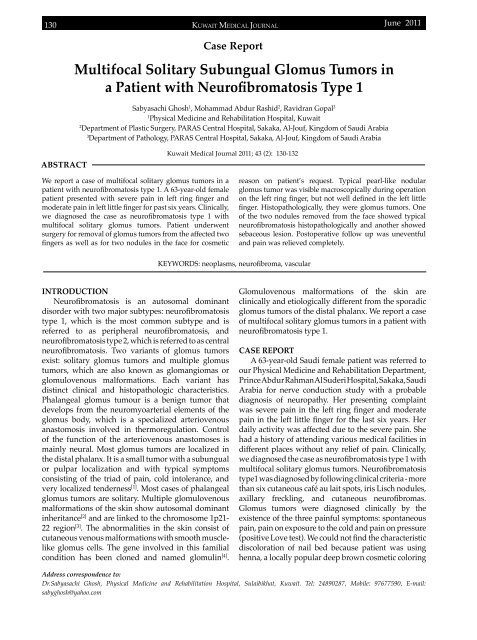Vol 43 # 2 June 2011 - Kma.org.kw
Vol 43 # 2 June 2011 - Kma.org.kw
Vol 43 # 2 June 2011 - Kma.org.kw
You also want an ePaper? Increase the reach of your titles
YUMPU automatically turns print PDFs into web optimized ePapers that Google loves.
130<br />
KUWAIT MEDICAL JOURNAL<br />
<strong>June</strong> <strong>2011</strong><br />
Case Report<br />
Multifocal Solitary Subungual Glomus Tumors in<br />
a Patient with Neurofibromatosis Type 1<br />
Sabyasachi Ghosh 1 , Mohammad Abdur Rashid 2 , Ravidran Gopal 3<br />
1<br />
Physical Medicine and Rehabilitation Hospital, Kuwait<br />
2<br />
Department of Plastic Surgery, PARAS Central Hospital, Sakaka, Al-Jouf, Kingdom of Saudi Arabia<br />
3<br />
Department of Pathology, PARAS Central Hospital, Sakaka, Al-Jouf, Kingdom of Saudi Arabia<br />
ABSTRACT<br />
Kuwait Medical Journal <strong>2011</strong>; <strong>43</strong> (2): 130-132<br />
We report a case of multifocal solitary glomus tumors in a<br />
patient with neurofibromatosis type 1. A 63-year-old female<br />
patient presented with severe pain in left ring finger and<br />
moderate pain in left little finger for past six years. Clinically,<br />
we diagnosed the case as neurofibromatosis type 1 with<br />
multifocal solitary glomus tumors. Patient underwent<br />
surgery for removal of glomus tumors from the affected two<br />
fingers as well as for two nodules in the face for cosmetic<br />
reason on patient’s request. Typical pearl-like nodular<br />
glomus tumor was visible macroscopically during operation<br />
on the left ring finger, but not well defined in the left little<br />
finger. Histopathologically, they were glomus tumors. One<br />
of the two nodules removed from the face showed typical<br />
neurofibromatosis histopathologically and another showed<br />
sebaceous lesion. Postoperative follow up was uneventful<br />
and pain was relieved completely.<br />
KEYWORDS: neoplasms, neurofibroma, vascular<br />
INTRODUCTION<br />
Neurofibromatosis is an autosomal dominant<br />
disorder with two major subtypes: neurofibromatosis<br />
type 1, which is the most common subtype and is<br />
referred to as peripheral neurofibromatosis, and<br />
neurofibromatosis type 2, which is referred to as central<br />
neurofibromatosis. Two variants of glomus tumors<br />
exist: solitary glomus tumors and multiple glomus<br />
tumors, which are also known as glomangiomas or<br />
glomulovenous malformations. Each variant has<br />
distinct clinical and histopathologic characteristics.<br />
Phalangeal glomus tumour is a benign tumor that<br />
develops from the neuromyoarterial elements of the<br />
glomus body, which is a specialized arteriovenous<br />
anastomosis involved in thermoregulation. Control<br />
of the function of the arteriovenous anastomoses is<br />
mainly neural. Most glomus tumors are localized in<br />
the distal phalanx. It is a small tumor with a subungual<br />
or pulpar localization and with typical symptoms<br />
consisting of the triad of pain, cold intolerance, and<br />
very localized tenderness [1] . Most cases of phalangeal<br />
glomus tumors are solitary. Multiple glomulovenous<br />
malformations of the skin show autosomal dominant<br />
inheritance [2] and are linked to the chromosome 1p21-<br />
22 region [3] . The abnormalities in the skin consist of<br />
cutaneous venous malformations with smooth musclelike<br />
glomus cells. The gene involved in this familial<br />
condition has been cloned and named glomulin [4] .<br />
Glomulovenous malformations of the skin are<br />
clinically and etiologically different from the sporadic<br />
glomus tumors of the distal phalanx. We report a case<br />
of multifocal solitary glomus tumors in a patient with<br />
neurofibromatosis type 1.<br />
CASE REPORT<br />
A 63-year-old Saudi female patient was referred to<br />
our Physical Medicine and Rehabilitation Department,<br />
Prince Abdur Rahman Al Suderi Hospital, Sakaka, Saudi<br />
Arabia for nerve conduction study with a probable<br />
diagnosis of neuropathy. Her presenting complaint<br />
was severe pain in the left ring finger and moderate<br />
pain in the left little finger for the last six years. Her<br />
daily activity was affected due to the severe pain. She<br />
had a history of attending various medical facilities in<br />
different places without any relief of pain. Clinically,<br />
we diagnosed the case as neurofibromatosis type 1 with<br />
multifocal solitary glomus tumors. Neurofibromatosis<br />
type1 was diagnosed by following clinical criteria - more<br />
than six cutaneous café au lait spots, iris Lisch nodules,<br />
axillary freckling, and cutaneous neurofibromas.<br />
Glomus tumors were diagnosed clinically by the<br />
existence of the three painful symptoms: spontaneous<br />
pain, pain on exposure to the cold and pain on pressure<br />
(positive Love test). We could not find the characteristic<br />
discoloration of nail bed because patient was using<br />
henna, a locally popular deep brown cosmetic coloring<br />
Address correspondence to:<br />
Dr.Sabyasachi Ghosh, Physical Medicine and Rehabilitation Hospital, Sulaibikhat, Kuwait. Tel: 24890287, Mobile: 97677590, E-mail:<br />
sabyghosh@yahoo.com
















